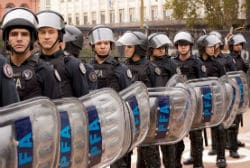Argentina released official crime statistics for the first time in eight years, and the numbers suggest that growing alarm among Argentines over increased crime and drug trafficking may be premature.
On April 25, authorities published official crime data for what they say is the first time since 2008, when former President Cristina Fernández de Kirchner was beginning her first term in office.
The report (pdf) shows the rates for most types of crimes remained relatively stable between 2008 and 2015. The country’s homicide rate went up slightly from 6.0 per 100,000 in 2008 to 6.6 per 100,000 in 2015 (see graph below), while reports of robbery rose by nine percent. One exception is the number of victims of sexual crimes, which grew by 78 percent. In total, the rate for all crimes committed climbed 10 percent during the eight-year period.

The report only provided data on drug trafficking for 2014 and 2015. Authorities seized 6,038 kilos of cocaine in 2015, a 42 percent drop from the previous year. (See graph below) Last year’s figures are slightly less than half of the 12,122 kilos of cocaine security forces seized in 2008, reported Clarín.

Security Minister Patricia Bullrich dismissed the idea that these figures indicate cocaine trafficking is on the decline in Argentina.
“It is really an important drop and we do not think that less cocaine entered Argentina” in 2015, she said.
InSight Crime Analysis
It’s important not to put too much stock in these numbers. As Bullrich pointed out, seizure data is not necessarily a good indicator of the volume of drugs passing through a country. Mexico, for instance, consistently seizes much less cocaine than smaller countries such as Costa Rica and Panama, but there is no question Mexico is the principal gateway into the world’s largest consumer of the drug, the United States.
Moreover, many crimes in Latin America — apart from homicides — are believed to have a high “cifra negra,” or black number, which refers to the number of crimes that go unreported. Fluctuations in crime statistics can just as easily be the result of a change in the number of unreported crimes as a meaningful difference in the security situation.
Still, the data provides some clues about whether the reality of Argentina’s crime situation matches the perception of the general population. Taking the numbers at face value, it does not appear that crime rose as dramatically during the Kirchner administration as many Argentines — including Pope Francis — had feared.
SEE ALSO: Coverage of Argentina
How a country’s population perceives crime is important because it can have a significant impact on security policies.
Reflecting growing public anxiety over drug trafficking and other criminal activity, the top three candidates in last year’s presidential campaign all promised to be tougher on crime than Kirchner. President Mauricio Macri made good on his promise by issuing an executive decree in January that permits the country’s armed forces to shoot down suspected drug planes.
That and other aggressive steps taken by Macri to lower crime rates have raised concern that Argentina’s domestic security apparatus is moving down a militarized path that will be difficult to backtrack from.

